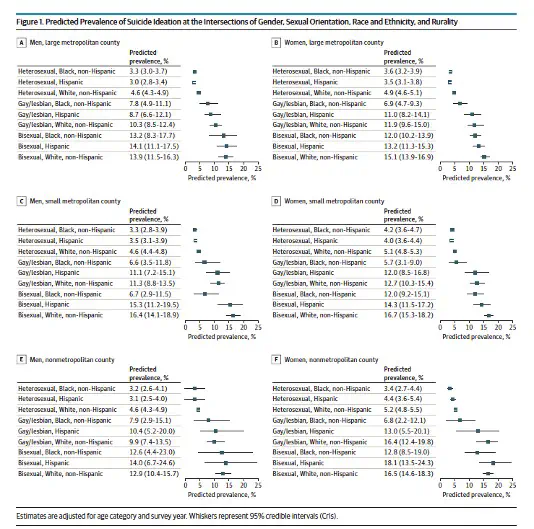Inequities and disparities
 Forrest et al. (2023). JAMA Psychiatry
Forrest et al. (2023). JAMA PsychiatrySuicidal thoughts and behaviors disproportionately affect sexual and gender minorities. Most research on this topic assesses either group-level processes (e.g., structural stigma) or individual-level processes (e.g., emotion regulation). However, if suicide were caused only by group-level processes, all LGBTQIA+ people would experience suicidal thoughts and behaviors. On the other hand, if suicide were caused only by individual-level processes, we wouldn’t expect to see rates of suicidal thoughts and behaviors be 4-6x higher in LGBTQIA+ people relative to heterosexual and cisgender people. Since neither of these scenarios is true, I think suicide in LGBTQIA+ people must be caused by both group-level and individual-level risk processes. My work in this area is dedicated to uncovering how group-level and individual-level risk processes interact and lead to suicidal thoughts and behaviors in sexual and gender minority people.
Moreover, this work is grounded in Black feminist scholarship’s intersectionality theory. Crucially, this work is explicit that health disparities for women, LGBTQIA+ people, or people of color are caused by structural forms of power, privilege, and oppression. In other words, this work assumes that LGBTQIA+ suicide disparities arise not because there is something unique about being LGBTQIA+ that increases suicide risk, but because LGBTQIA+ people live in a society with heterosexist, homophobic, and transphobic legislation, behaviors, and beliefs; it is heterosexism, homophobia, and transphobia that increase suicide risk for LGBTQIA+ people.
Example questions I tackle in this area include:
- How do suicide risk processes differ based on individuals’ identities?
- How do structural processes impact individual-level experiences (esp of suicide and eating disorders)?
- How do structural-level and individual-level processes interact and impact suicide and eating disorders?
Example papers in this content area include, but are not limited to:
Forrest, L. N., Beccia, A., Gehman, S., Exten, C., & Ansell, E. B. (in press). Intersectional prevalence of suicide ideation, plan, and attempt based on gender, sexual orientation, race and ethnicity, and rurality. JAMA Psychiatry.
Forrest, L. N., Smith, A. R., & Swanson, S. A. (2017). Characteristics of seeking eating disorder treatment among U.S. adolescents. International Journal of Eating Disorders, 50, 826–833.
Velkoff, E., A., Forrest, L. N., Dodd, D. R., & Smith, A. R. (2016). Identity security, relationship satisfaction, and disclosure: Predictors of suicide risk factors among sexual minority women. Psychology of Women Quarterly, 40, 261–274.